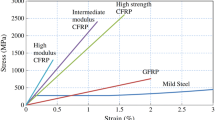Abstract
To enhance the durability of a reinforced concrete structure, engineered cementitious composite (ECC), which exhibits high tensile ductility and good crack control ability, is considered a promising alternative to conventional concrete. However, broad application of ECC is hindered by its high cost. This paper presents a new means to address this issue by introducing a composite beam with a U-shaped ECC permanent formwork and infill concrete. The flexural performance of the ECC/RC composite beam has been investigated experimentally with eight specimens. According to the test results, the failure of a composite beam with a U-shaped ECC formwork is initiated by the crushing of compressive concrete rather than debonding, even if the surface between the ECC and the concrete is smooth as-finished. Under the same reinforcement configurations, ECC/RC composite beams exhibit increases in flexural performance in terms of ductility, load-carrying capacity, and damage tolerance compared with the counterpart ordinary RC beam. Furthermore, a theoretical model based on the strip method is proposed to predict the moment-curvature responses of ECC/RC composite beams, and a simplified method based on the equivalent rectangular stress distribution approach has also evolved. The theoretical results are found to be in good agreement with the test data.
Similar content being viewed by others
References
Gergely P, Lutz L A. Maximum crack width in reinforced concrete flexural members. American Concrete Institute, 1973, 20: 87–117
Li V C, Leung C K Y. Steady state and multiple cracking of short random fiber composites. Journal of Engineering Mechanics, 1992, 118(11): 2246–2264
Li V C, Stang H, Krenchel H. Micromechanics of crack bridging in fiber reinforced concrete. Materials and Structures, 1993, 26(8): 486–494
Li V C, Mishra D K, Wu H C. Matrix design for pseudo-strain-hardening fibre reinforced cementitious composites. Materials and Structures, 1995, 28(10): 586–595
Li V C, Wu H C, Chan Y W. Effect of plasma treatment of polyethylene fibers on interface and ementitious composite properties. Journal of the American Ceramic Society, 1996, 79(3): 700–704
Li V C, Wang S, Wu C. Tensile strain-hardening behavior of polyvinyl alcohol engineered cementitious composite (PVA-ECC). ACI Materials Journal, 2001, 98(6): 483–492
Şahmaran M, Li V C, Li M. Transport properties of engineered cementitious composites under chloride exposure. ACI Materials Journal, 2007, 104: 604–611
Wang K, Jansen D, Shah S, Karr A. Permeability study of cracked concrete. Cement and Concrete Research, 1997, 27(3): 381–393
Lepech M D, Li V C. Long term durability performance of engineered cementitious composites. Restoration of Buildings and Monument, 2006, 12(2): 119–132
Wang S X, Li V C. Engineered cementitious composites with high-volume fly ash. ACI Materials Journal, 2007, 104(3): 233–241
Pan Z F, Wu C, Liu J Z, Wang W, Liu J W. Study on mechanical properties of cost-effective polyvinyl alcohol engineered cementitious composites (PVA-ECC). Structure and Building Material, 2015, 78(3): 397–404
Fischer G, Li VC. Influence of matrix ductility on tension stiffening behavior of steel reinforced engineered cementitious composites. ACI Structural Journal, 2002, 99(1): 104–111
Maalej M, Li V C. Introduction of strain hardening engineered cementitious composites in design of reinforced concrete flexural members for improved durability. ACI Structural Journal, 1995, 92(2): 167–176
Leung C K, Cao Q. Development of pseudo-ductile permanent formwork for durable concrete structures. Materials and Structures, 2010, 43(7): 993–1007
Yuan F, Pan J L, Leung C K Y. Flexural behaviors of ECC and concrete/ECC composite beams reinforced with basalt fiber-reinforced polymer. Journal of Composites for Construction, 2013, 17(5): 591–602
Li Q H, Xu S L. Experimental investigation and analysis on flexural performance of functionally graded composite beam crack-controlled by ultrahigh toughness cementitious composites. Science in China Series E: Technological Sciences, 2009, 52(6): 1648–1664
Yang E H, Yang Y, Li V C. Use of high volumes of fly ash to improve ECC mechanical properties and material greenness. ACI Materials Journal, 2007, 104(6): 620–628
Qian S Z, Li V C. Simplified inverse method for determining the tensile properties of strain hardening cementitious composites (SHCC). Journal of Advanced Concrete Technology, 2008, 6(2): 353–363
American Association of State Highway and Transportation Officials (AASHTO). AASHTO LRFD Bridge Design Specifications. 4th ed. Washington D. C.: AASHTO, 2007
Rashid M A, Mansur M A. Reinforced high-strength concrete beams in flexure. ACI Structural Journal, 2005, 102(3): 462–471
Lepech M, Li V C. Water permeability of cracked cementitious composites. In: Proceedings of the 11th International Conference on Fracture. CD ROM, 2005
Maalej M, Li V C. Flexural/tensile strength ratio in Engineered Cementitious Composites. Journal of Materials in Civil Engineering, 1994, 6(4): 513–528
Hognestad E, McHenry D, Hanson N W. Concrete stress distribution in ultimate strength design. Journal of the American Concrete Institute, 1955, 27(4): 455–479
Rüsch H. Researches toward a general flexural theory for structural concrete. Journal of the American Concrete Institute, 1960, 57(1): 1–28
Wu Y F, Oehlers D J, Griffith M C. Rational definition of the flexural deformation capacity of RC column sections. Engineering Structures, 2004, 26(5): 641–650
ACI Committee 318. Building code requirements for structural concrete (ACI 318-14). American Concrete Institute, Farmington Hills, MI, 2014
Acknowledgements
The authors acknowledge the funding supports of National Key Research and Development Plan, China (2016YFC0701400, 2017YFC1500700), and the National Natural Science Foundation of China (Grant No. 51778462).
Author information
Authors and Affiliations
Corresponding author
Rights and permissions
About this article
Cite this article
Qiao, Z., Pan, Z., Xue, W. et al. Experimental study on flexural behavior of ECC/RC composite beams with U-shaped ECC permanent formwork. Front. Struct. Civ. Eng. 13, 1271–1287 (2019). https://doi.org/10.1007/s11709-019-0556-0
Received:
Accepted:
Published:
Issue Date:
DOI: https://doi.org/10.1007/s11709-019-0556-0




